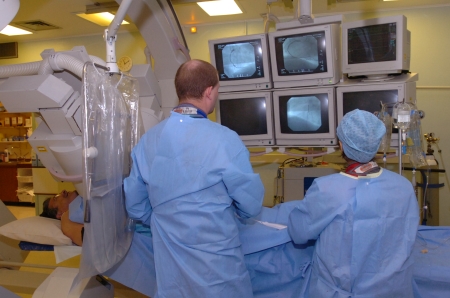Recent results of a randomized trial showed that taking a more conventional appraoch in determining which coronary lesions would require percutaneous intervention did not harm or derail patient outcomes in any way.
According to Hyeon-Cheol Gwon, MD, PhD, of Samsung Medical Center in Seoul, South Korea, the 1-year rate of all-cause of death,myocardial infarction, and any revascularization was 7.3% when stenosis of more than 70% was used as the starting point and 6.8% when stenosis of more than 50% was used (HR 1.05, 95% CI 0.63-1.74).
The differentiation matched criteria for noninferiority (P=0.0055), Gwon reported at the Transcatheter Cardiovascular Therapeutics meeting.
"The revascularization of an angiographically intermediate lesion can be deferred safely," he said.
Other cardiologists who looked at and commented on the results agreed that using an angiographic cutoff of 50% stenosis was not helpful in determining which lesions to revascularize. However, they argued for the need for more accurate information on lesions in the intermediate range of 50% to 70% stenosis using fractional flow reserve (FFR).
"Revascularization of all 50% lesions is not necessary but I still think that there's a place for physiologic assessment of the intermediate lesion," said Philippe Genereux, MD, of the Hopital du Sacre-Coeur de Montreal.
Genereux’s comments were met in agreement by Bernard Gersh, MBChB, DPhil, of the Mayo Clinic in Rochester, Minn.
"What FFR measurements have taught us is if you look at the 50% to 70% stenoses, intermediate stenoses, there is a wide range of FFR in that group and it seems to correlate with clinical events. We've gone beyond visual assessment,” said Gersh.
However, Gwon contested that there should be a comparison between the outcomes when using the more aggressive angiographic cutoff of 50% stenosis for PCI, as specified in U.S. guidelines, or when using the more conventional cutoff of 70% stenosis, as specified in the European guidelines, because FFR is employed in only a minority of cases. “Most center, still rely on angiographic assessment,” said Gwon.
He and his peers examined the matter in the SMART-CASE trial, an open-label, randomized study performed at 16 centers in South Korea. The trial included 899 patients (average age about 65) who had a target lesion resulting in 50% to 70% stenosis, as calculated by quantitative coronary angiography, in a native coronary artery eligible for PCI. They were randomized as a means to have only those lesions greater than 70% stenosis stented or to have lesions greater than 50% stented.
The Xience V everolimus-eluting stent was used whenever PCI was pronounced. Using the more traditional 70% cutoff, nearly half (47.4%) of the patients were not administered any stents at all.
Through the first year, clinical outcomes were comparable between the two groups. The rate of mortality or MI (leaving out the revascularization part of the main endpoint) was numerically lower in the conventional group, but the difference did not achieve statistical significance (1.4% versus 2.7%; HR 0.50, 95% CI 0.19-1.33).
There was also no real difference in the rate of any revascularization (6.8% with conservative versus 4.8% with aggressive; HR 1.42, 95% CI 0.80-2.52), albeit the rate of revascularization of the target lesion only was higher in the conservative group (4.1% versus 1.7%; HR 2.47, 95% CI 1.02-5.95).
“The absolute rate was still low in both groups,” said Gwon.
In a subgroup analysis, there was a considerable interaction with age (P=0.02), such that patients who were 65 and older tended to do better with the conservative strategy and younger patients tended to do better with the aggressive strategy.
Gwon recognized that the study was limited due to the wide noninferiority margin used, the lack of statistical power for hard clinical endpoints, the short duration of follow-up, and the lack of FFR measurements.











